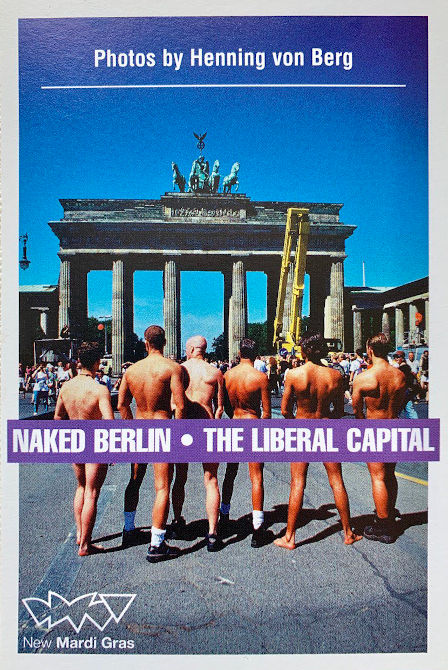
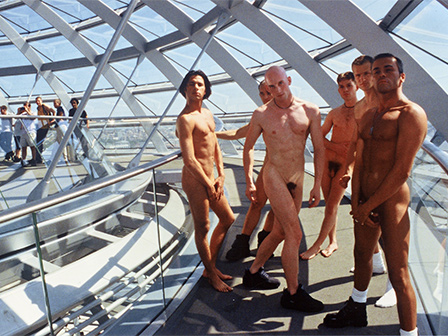

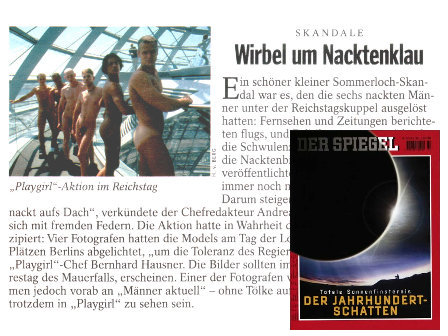
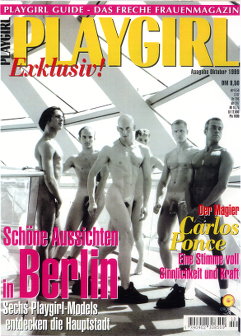
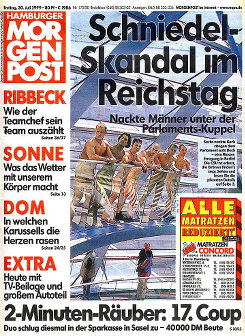
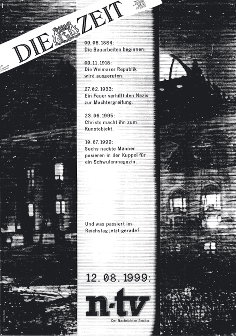
The Scandal Photo Shoot
"Berlin Naked – Liberal Capital City"
THE CONCEPT
In autumn 1998, Dr. Dietmar Kreutzer, author of the best-selling book about nude males in advertising (KAUF MICH – "Maenner in der Werbung"), and the photographer Henning von Berg created the concept of an unusual project for the summer 1999:
A unique group shoot at public places to document clearly the tolerance and the open-minded climate of modern Germany. Six men were chosen to pose naked in public around the old / the new capital Berlin.
This was to be connected to a promotional story for Kreutzer's planned second book about male modeling careers (MAENNER MODELS PUR – "Modeling in Germany"). Two gifted photographer colleagues of Von Berg were invited to support the project: Suzanne de Brito-Schroeder (Munich) and Jovan Evermann (Cologne).
The very first publication of the photos was to be in Germany's PLAYGIRL magazine in October 1999. The coffee table book debut was planned for November 1999.
BACKGROUND HISTORY
In October 1990, 45 years after the end of World War II, and 1 year after the collapse of the dictatorship in the Russian allied sector (in former East Germany), the reunited German parliament "Deutscher Bundestag" decided to move the capital and its government departments of the newly reunited country from the quiet small city of Bonn to the re-awakening metropolis of Berlin.
Many people worldwide were hesitant of this larger unified country and the change of the capital city. They had not realized that within the last half century the state of Germany has been transformed into one of the foremost modern, western democracies. The ‘Bundesrepublik Deutschland' is a well-functioning democracy and far more liberal then most other countries!
The monumental building "Reichstag" was built in 1889 and hosted the parliament in both, its most successful and most tragic times: The "Prussian Kingdom", a monarchy (18th -19th centuries). The "Second German Reich", an Imperial monarchy (1871-1918). Then the "Republic of Weimar", the first democratic state (1918-1933). And last, the "Third German Reich", the Nazi's dictatorship (1933-1945).
In 1990, German politicians wanted to make a strong statement to the world by choosing this historically tarnished building for their democratic parliament. The old ‘Reichstag' should become the home of the new "Deutscher Bundestag".
The renowned British architect, Sir Norman Foster, was employed to transform the traditional structure into a more futuristic landmark. One of the main aspects of the contemporary design was to permit every citizen to enter the building. Foster created a tremendous glass dome on the roof, which can be visited by the public to watch the parliament in action. This glass construction was meant to symbolize the transparency of German politics.
THE PHOTO SHOOT
The actual photo shoot on July 7th, 1999 was much less complicated then expected. The book author, three main photographers, two photographer-helpers, and the six courageous models walked through the center of the city to ten famous landmarks. On command, the six men stripped naked and were photographed.
The 10 sightseeing points were: the new Daimler Benz-Headquarters; Marlene-Dietrich-Platz at the rebuilt "Potsdam Square"; the glass dome of the parliament building "Reichstag"; Germany's national symbol, the "Brandenburg Gate"; celebrity lounge "Café Einstein" Unter Den Linden; in front of the French luxury department store "Galeries Lafayette"; entrance of the metro station "Franzoesische Strasse"; bathing in the fountain on "Wittenberg Square" Europe's largest department store "KaDeWe"; and strolling the zebra crossing on Berlin's main shopping boulevard, "Tauentzien/Kurfuerstendamm".
Throughout the city tour, thousands of tourists enjoyed the show with much applause and whistling. Nobody demanded an arrest of the lively photo-shoot group, not even in the parliament building. At two locations, observant police cars passed by slowly. On Tauentzien boulevard the friendly policemen asked very politely to stop the merrily shooting, which was done immediately, because the complete traffic had come to a hold. But the authorities never confiscated any of the films. And the six bare men had a really great time with lots of fun in the hot sun on this beautiful summer day.
The photo results were intended to be published in Germany's PLAYGIRL magazine (in October) and the coffee table book about modeling (in November). The magazine editor and the book author worked hard to achieve these goals.
THE "SCANDAL"
Suddenly, a scandal started when one of the photographer-helpers tried to gain personal attention by selling unauthorized photos of the "Reichstag" nude-shoot to a gay magazine. The brazen chief-editor of MAENNER AKTUELL printed two pictures (in August). Unfortunately the snapshots were shown without any explanation of Henning von Berg's motives for the shoot.
Immediately, the two pictures were also re-published in numerous international newspapers worldwide. In Germany a few conservative politicians and priests screamed…. and the culprit photographer-helper went proudly from TV talk show to TV talk show to shine in the limelight. Later, in October and November the true story was published in PLAYGIRL magazine and the book MAENNER MODELS PUR. Also Europe’s renowned news magazine DER SPIEGEL published the truth. Through litigation, a half year later, the culprit photographer-helper had to pay a penalty to the models.
THE MORAL OF THE STORY
As a result some lawyers became rich but at least nobody penalized the initial author Dietmar Kreutzer, or the concept planner/photographer Henning von Berg, or the two other photographers Suzanne de Brito-Schroeder and Jovan Evermann. Proof that the arts are unrestricted in liberal Germany.
Important for this whimsical project was not so much the perfect posing of the models in front of the cameras, as was the spontaneous happening of naked models on public streets. Also it became the world’s first and only-ever male nude photo shoot inside a parliament.
Here you can see some samples of that fun shoot. There are many more images available from the photographer's archives, which haven't been shown yet. On request, interested publishers will find a wealth of material for very special editorial stories.
(Translation: Ron Anderegg, Los Angeles)